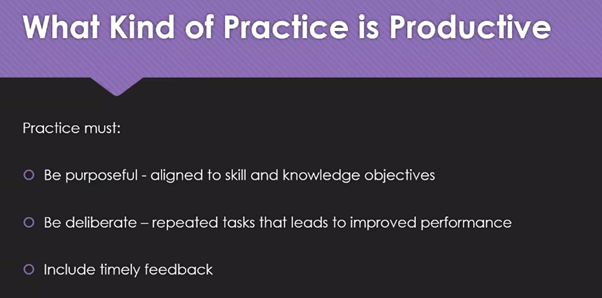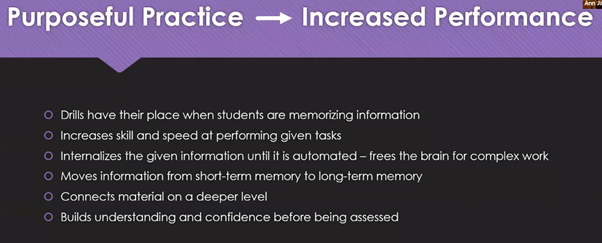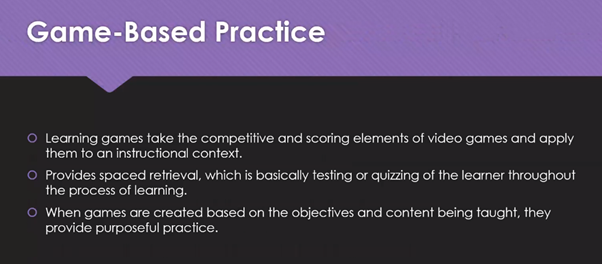Purposeful Practice to Improve Performance with Game-based Interactions
Purposeful practice provides learners with the opportunity to repeat steps or review information to improve skills and knowledge. There are several forms of practice. However, there are three main aspects that contribute to making practice productive – it must be purposeful, it must be deliberate, and it must include timely feedback. Let us look at these factors in detail.
Qualities of Productive Practice

For practice to be purposeful, it needs to be aligned to the skills and knowledge that you are teaching at that time. To share an example, publishers of textbooks come with already prepared practice activities. Although they may align with the content in the text, they may not necessarily focus on the objectives that are covered in the course. Hence, it is a good idea to create your practice activities that focus on the content and skills that are aligned to your specific objectives.
To be deliberate, practice must include tasks that are repeated, with the goal of improving performance. For instance, when trying to teach new vocabulary, deliberately repeating the words makes the practice very productive. Additionally, with deliberate, one needs to share new content in class and then provide students with practice before they are given an assignment to be evaluated on that content. Unfortunately, most of the time, higher-ed teachers cover a piece of content, have a student read it from the textbook, and immediately give them an assignment. Instead, it is important to realize that there must be a deliberate practice where students can interact with that information, before assessing them. Students need to practice that skill before being evaluated.
Finally, for practice to be productive, there must be timely feedback. It needs to be as immediate as possible and should provide guidance. Such feedback corrects any kind of misconceptions among students and provides positive reinforcement.
How Does Purposeful Practice Increase Performance?

Skill and drill: This kind of practice can be beneficial when you need students to memorize information or memorize the steps taught in a specific technique. If a process requires several steps, the steps can be memorized in the correct order so that students can focus on the complex task of completing the steps accurately rather than focusing on what comes next.
Internalize: For practice to be beneficial, the content has to be sufficiently practiced for the information to be internalized. If students memorize a bunch of terms and never put those into practice, or learn the steps of a routine or tasks, but if they are never really asked to apply those, then that content doesn’t become internalized. Hence, students need to practice applying the content. Practicing over and over again also increases their skill and speed. For example, in the healthcare field, if the students don’t know the medical terms and they are in the middle of a conversation or performing a task, they do not have the time to stop and look up that medical term or look up what step comes next. Instead, they need to practice and internalize those steps so that they know what to do next, without having to focus on the actual process. This allows them to directly focus on the content.
This kind of practice moves the information from short-term memory to long-term memory. If students just read the information and they don’t have a lot of opportunities to interact with that content or those skills, it just remains in the short-term memory and is soon forgotten. Practice gives students a thorough understanding of the content and an opportunity to review it, thus building a deeper understanding and confidence.
Role of Game-based Practice

Let us now understand how game-based practice fits into this. We all know how addictive games can be. This is mainly because they encode the elements of competition and also some kind of scoring. There is a lot of research that shows that if students practice content and are quizzed on it or tested on it, over a long period of time, which is the exact opposite of cramming for a test, they learn the content much better. For instance, they can read a little bit of the chapter and then take some quizzes or play games based on that content, it helps them learn the content more thoroughly and understand it more deeply, rather than just reading the entire chapter and doing one assignment.
Learning games can provide this kind of purposeful practice, an opportunity known as space retrieval. Another benefit is that based on the learning objectives, higher-ed teachers can check students’ understanding and reinforce the content to make sure that along with the practice, those objectives are truly achieved.
How to Design Effective Purposeful Practice
When creating any kind of practice activities, always start with the objectives. Think about what the objective is asking the students to do and determine which of those objectives can best be met through game-based practice. There are times when objectives require prerequisite skills that could be reviewed with game-based practice. For instance, if you have taught a lesson on note-taking in the past and now you need to ask students to apply it again in a new area. Then it would be beneficial to have some kind of practice to review those strategies and activate their prior knowledge before they complete the note-taking assignment.
Once the objectives are determined then it is easier to decide what kind of game or activity would best provide the practice. Let’s say the objective is doing memorization of math facts or math formulas. Typically, students would need to go back and continually look up those formulas. Instead, you can use games to really establish those formulas in their mind and then create a game incorporating the feedback for the practice.
Raptivity has some interesting games for higher-ed educators, professors, and corporate trainers. For example, there’s Balloon Pop and Reach Your Goal Faster. All the interactions are customizable – you can add the necessary content or questions, add your own audio/images/video, change the font, and create your assessment exactly the way you want to accomplish your objectives. In fact, you can also provide feedback to the students. In short, these interactions are very simple to create and allow you to focus on your content as opposed to using some pre-determined content. These are the videos for any questions on customizing Raptivity interactions.
For practice to be purposeful, it cannot be just rote repetition. This is particularly important for higher education. Purposeful practice must encourage higher ed students to practice more, build on existing knowledge, and should provide them timely relevant feedback. Through designing practice activities based on learners’ specific needs and desired outcomes, practice becomes purposeful.
Leave a comment